ACTIVITIES AND ACCOMPLISHMENTS
Objectives and Achievements
A number of objectives were set at the start of the project and have been accomplished as follows.
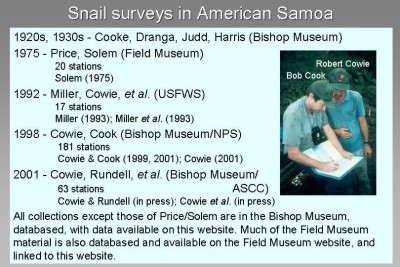
- Capture all data from Samoan non-marine material in Bishop Museum's collections. Data from all non-marine snail lots (11,768 lots) from American Samoa and Samoa (formerly Western Samoa) collected both prior to the project and during the course of the project have been entered into the general collection database. Approx. 1800 new lots were incorporated. All specimens were reviewed and identifications checked by Dr. Robert Cowie, the project leader. All nomenclature has been updated, based on the Catalog of the nonmarine snails and slugs of the Samoan Islands and the data are accessible on the searchable database.
- Review of the Samoan land snail material in the Field Museum (Chicago). The Field Museum holds the second largest collection of Samoan non-marine snails (after the Bishop Museum), although it is less than 10 % the size of the Bishop Museum collection. Approximately half the Field Museum material is now databased and on the web, and linked to the Bishop Museum's searchable database.
- Sort and identify material from recent and projected surveys in Samoa. All previously unaccessioned, unsorted, and unidentified material from [Western] Samoa and American Samoa held in the Bishop Museum, as well material resulting from field work undertaken since the start of the Samoan Snail Project, has been accessioned, sorted, identified, cataloged, and entered into the searchable database.
- Undertake field work to ascertain further the current status and distribution of the fauna. Three field trips were undertaken in 1998 to the islands of Tutuila, Ta‘u, and Ofu; and two in 2001 to the islands of Tutuila, Ofu, Olosega, and Aunu‘u. In addition, two assistants/trainees from the American Samoa Community College undertook independent field work on Tutuila as part of their training under the project.
- Produce a simple field guide for use in Samoa. A hard copy draft of Samoan Land Snails and Slugs: A Field Identification Guide was tested by the Samoan trainees in 2001. A hard copy version is planned.
- Build synoptic reference collections to be deposited in American Samoa and [Western] Samoa. Reference collections were placed in the National Park of American Samoa and the American Samoa Community College (Land Grant Program). It has not yet been possible to deposit one in [Western] Samoa.
- Train graduate students from the University of Hawaii. Four graduate students have been employed as Research Assistants under the grant. They all gained training in modern natural history museum practices and familiarity with the Samoan snail fauna.
Research findings
The data from the 1998 survey work in American Samoa have been analyzed and compared with data obtained from the literature and from previous survey work to ascertain the conservation status of the Samoan snail fauna. Findings from the 1998 survey work were:
- The surveys recorded 19 of the 42 previously known native land snail species, 11 of the 12 aliens, and 3 of the 6 cryptogenic (unknown origin) species previously known from American Samoa.
- Eight species were recorded for the first time: 3 described species that are presumed to be native, 4 nonindigenous species; and 1 cryptogenic species.
- Two undescribed and presumed endemic species were discovered, as was one unidentified and perhaps undescribed species.
- One species, previously thought to be extinct was rediscovered, although in very small numbers.
- The known island distributions of 11 species (5 native, 5 alien, 1 cryptogenic) were extended.
- Comparisons with surveys undertaken predominantly in the 1920s and 1930s, 1975, and 1992 showed that the fauna is becoming a homogeneous subset of Pacific-wide and pantropical alien species, as these species replace the declining native/endemic diversity.
- Focus on the four listed partulid tree snails showed that 1) Samoana abbreviata, previously thought to be extinct, was recorded alive, although it was extremely rare; 2) the commonest species, Eua zebrina, was found for the first time on Ofu; 3) Samoana conica (the second most common species) was still extant; 4) the extremely rare and highly localized Samoana thurstoni was found in greater numbers than ever before by western science, though only 31 specimens (including these) have ever been reported (but see also subsequent field work in 2001, below); 5) all four species should be considered endangered, though E. zebrina perhaps less so than previously thought.
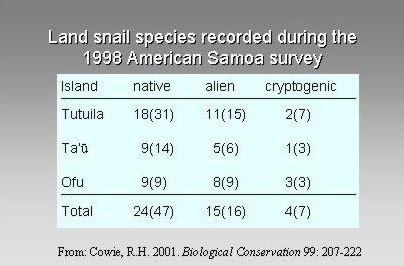 Numbers of species recorded in 1998 with, in parentheses, the total numbers known from each island. Data derived from Cowie (2001).
Numbers of species recorded in 1998 with, in parentheses, the total numbers known from each island. Data derived from Cowie (2001).
|
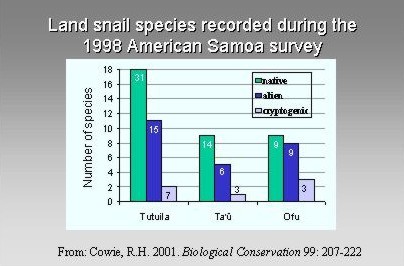 Numbers of species recorded in 1998 with, at the top of each bar, the total numbers known from each island. Date derived from Cowie (2001).
Numbers of species recorded in 1998 with, at the top of each bar, the total numbers known from each island. Date derived from Cowie (2001).
|
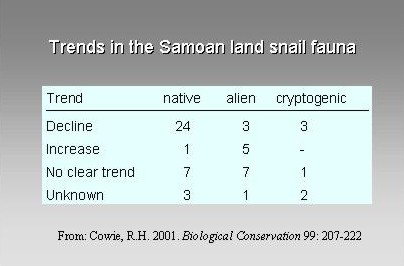
|
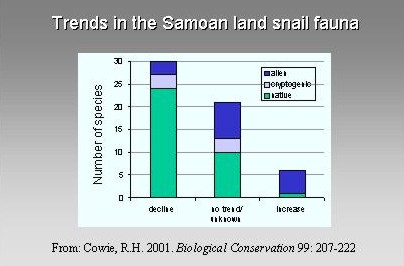
|
These findings have been published in:
Cowie, R.H. & Cook, R.P. 2001. Extinction or survival: partulid tree snails in American Samoa. Biodiversity and Conservation 10(2): 143-159.
Cowie, R.H. 2001. Decline and homogenization of Pacific faunas: the land snails of American Samoa. Biological Conservation 99(2): 207-222.
Field work in 2001 focused especially on the islands of Olosega and Aunu‘u. Findings from this field work were:
- Samoana thurstoni (see above) was discovered on Olosega. This is the first record of a partulid from this island and is of major conservation significance.
- The known land snail fauna of Olosega was increased from six to 30 species. Of these, 17 are native to the Samoan islands and 13 are introduced. This was the first time that snail surveys had ever been undertaken at high elevation on Olosega.
- The known land snail fauna of Aunu‘u was increased from two to 22 species. Of these, 12 are native to the Samoan archipelago, nine are introduced, and one is cryptogenic (of unknown origin).
- That these two relatively readily accessible islands (Olosega, Aunu‘u) were previously so poorly known malacologically, yet have now been shown to harbor significant land snail faunas, suggests that other less accessible islands in the Pacific may be even less well known. The need for much more survey work throughout the Pacific is very clear.
These findings were published in:
Cowie, R.H. & Rundell, R.J. 2002. The land snails of a small tropical Pacific island, Aunu'u, American Samoa. Pacific Science 56(2): 143-147.
Cowie, R.H., Rundell, R.J., Mika, F. and Setu, P. 2002. The endangered partulid tree snail Samoana thurstoni on Olosega and the land snail diversity of the Manu'a Islands, American Samoa. American Malacological Bulletin 17(1/2): 37-43.
Training and Human Resource Development
- Graduate assistants. Most of the time spent by three of the graduate assistants employed on the project was spent on data entry. They have become familiar with the Samoan fauna and with modern museum practices. This familiarity allowed one of them (Rebecca Rundell) to develop her own research project (with Robert Cowie, project leader as her advisor) on the evolution and ecology of succineid land snails in the Pacific. The main part of the thesis was a phylogenetic analysis of the Hawaiian and other Pacific succineid species, which included two species collected in American Samoa. She participated in field work in American Samoa as well as in the training of the Samoan field assistants (see below). She recently successfully defended her masters thesis and is going on to the PhD program at the University of Chicago, where she plans to continue research on Pacific land snails. The fourth graduate assistant (Richard Pyle) developed both the database structure for the project and the project website.
- Trainees. Two American Samoans and one [Western] Samoan were trained in land snail field survey techniques, and in the sorting, identification, and curation of the collected material. All three became familiar with the Samoan land snail fauna. Two of them are co-authors on a paper on the fauna of Olosega (see above).
- Field assistants. Twelve people assisted with fieldwork, six of them native Samoans, in 1998. An additional three people (plus the three trainees - see above) assisted with field work in 2001. See the Personnel and Acknowledgements page.
Contributions of the Samoan Snail Project to Biodiversity Conservation
The purpose of the project is to provide a foundation for assessing the diversity and historical decline of the native Samoan non-marine snail fauna, as a first step in its conservation. The searchable database generated by the project will facilitate monitoring of the fauna from a conservation perspective. Additionally, the project provides a rigorous and accurate information resource that will be an essential basis for any future study of the systematics of the fauna (Catalog of the nonmarine snails and slugs of the Samoan Islands). The project also makes available a basic bibliography for access to ecological and other biological information on the fauna. And in evaluating the status of the known alien species in Samoa, the project has provided background for their management. The web-based field guide (Samoan Land Snails and Slugs: A Field Identification Guide), which will eventually be published as a book, combined with the reference collections deposited in American Samoa are resources that will facilitate future study of the Samoan fauna.


 Numbers of species recorded in 1998 with, in parentheses, the total numbers known from each island. Data derived from Cowie (2001).
Numbers of species recorded in 1998 with, in parentheses, the total numbers known from each island. Data derived from Cowie (2001). Numbers of species recorded in 1998 with, at the top of each bar, the total numbers known from each island. Date derived from Cowie (2001).
Numbers of species recorded in 1998 with, at the top of each bar, the total numbers known from each island. Date derived from Cowie (2001).
